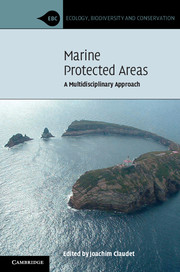Book contents
- Frontmatter
- Contents
- Contributors
- Introduction
- Part I Threats to marine ecosystems and resources
- Part II Effects of marine protected areas
- Part III Assessment of the effectiveness of marine protected areas
- Part IV Scale-up of marine protected area systems
- 11 NETWORKS – The assessment of marine reserve networks: guidelines for ecological evaluation
- 12 CONNECTIVITY – Spacing a network of marine protected areas based on connectivity data
- 13 REPRESENTATIVENESS – Effectiveness of the global network of marine protected areas
- 14 MISSING DIMENSION – Conserving the largest habitat on Earth: protected areas in the pelagic ocean
- Index
- References
14 - MISSING DIMENSION – Conserving the largest habitat on Earth: protected areas in the pelagic ocean
from Part IV - Scale-up of marine protected area systems
Published online by Cambridge University Press: 05 August 2012
- Frontmatter
- Contents
- Contributors
- Introduction
- Part I Threats to marine ecosystems and resources
- Part II Effects of marine protected areas
- Part III Assessment of the effectiveness of marine protected areas
- Part IV Scale-up of marine protected area systems
- 11 NETWORKS – The assessment of marine reserve networks: guidelines for ecological evaluation
- 12 CONNECTIVITY – Spacing a network of marine protected areas based on connectivity data
- 13 REPRESENTATIVENESS – Effectiveness of the global network of marine protected areas
- 14 MISSING DIMENSION – Conserving the largest habitat on Earth: protected areas in the pelagic ocean
- Index
- References
Summary
So far from the coast: is protection needed for pelagic habitats and species?
The pelagic environment is the area of the ocean from the surface to just above the sea floor and includes all the physical and chemical conditions and biology in the water column. This environment forms the largest habitat on Earth, constituting 99% of the biosphere volume (Angel, 1993). Pelagic ecosystems account for nearly half of the photosynthesis on Earth through phytoplankton (Field et al., 1998) and supply >80% of the fish consumed by humans (Pauly et al., 2002). These ecosystems also play a major role in the pace and extent of climate change via the uptake of carbon dioxide and its removal to the deep ocean through the biological pump, and via the dynamics of the overturning circulation within the solubility pump (Hays et al., 2005).
While the open ocean can be divided into a number of vertical zones (Figure 14.1), here we collectively refer to these zones as the pelagic environment, and focus on the upper 200 m of the water column where the majority of the life in the pelagic zone resides and where most human activities occur. Note that the benthopelagic region includes the sea floor, and is not a focus of this chapter, as benthic protected areas typically encompass only the immediate overlying water, or are located in shallow coastal regions where ocean processes do not occur. In shallow or coastal regions, the whole water column may be considered benthopelagic.
- Type
- Chapter
- Information
- Marine Protected AreasA Multidisciplinary Approach, pp. 347 - 372Publisher: Cambridge University PressPrint publication year: 2011
References
- 5
- Cited by

